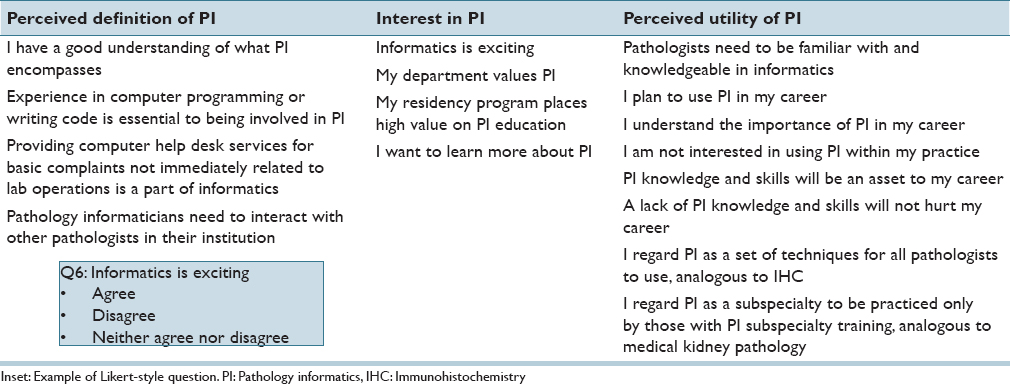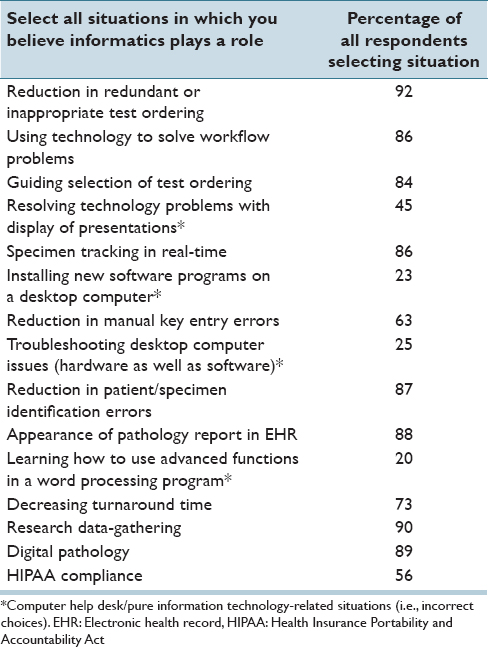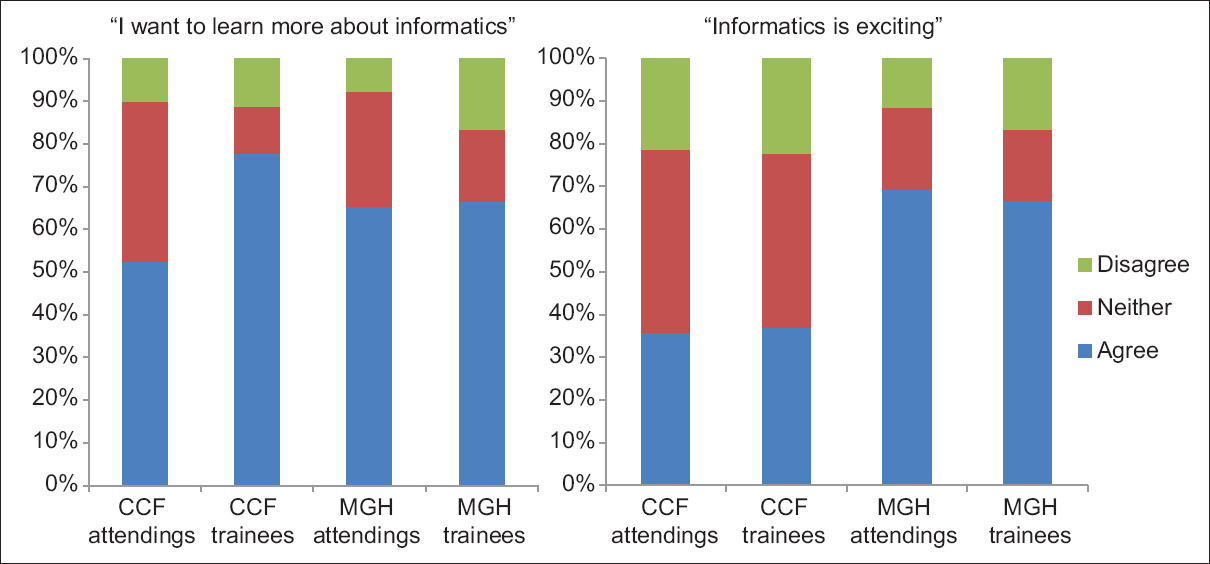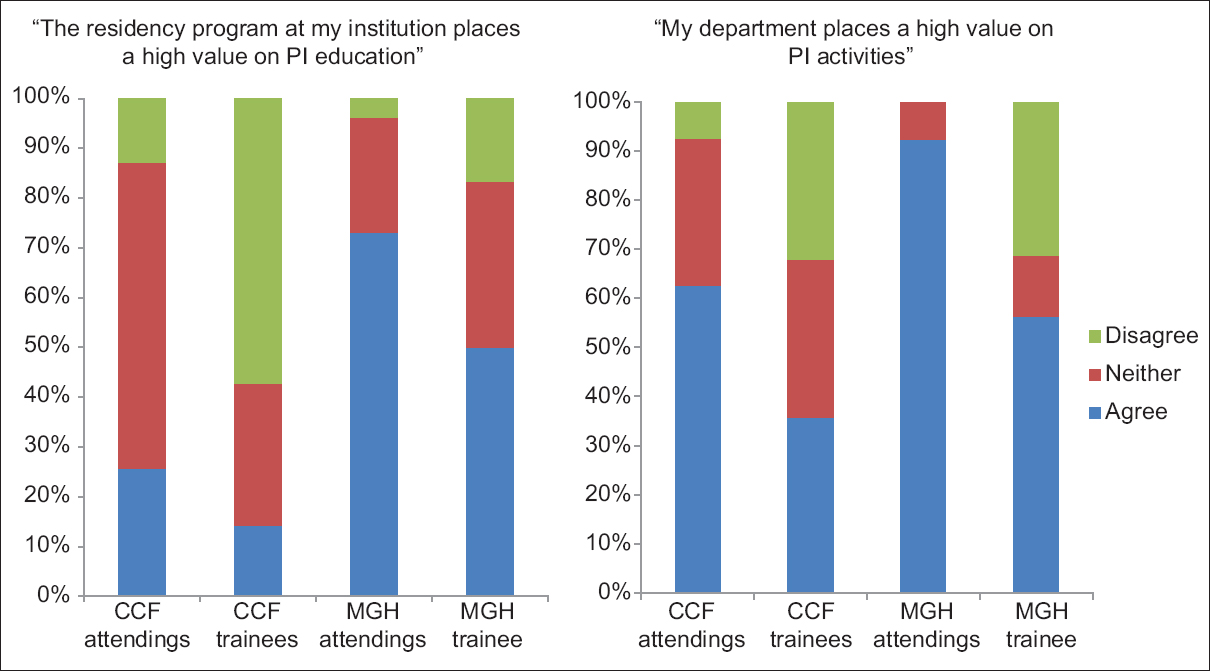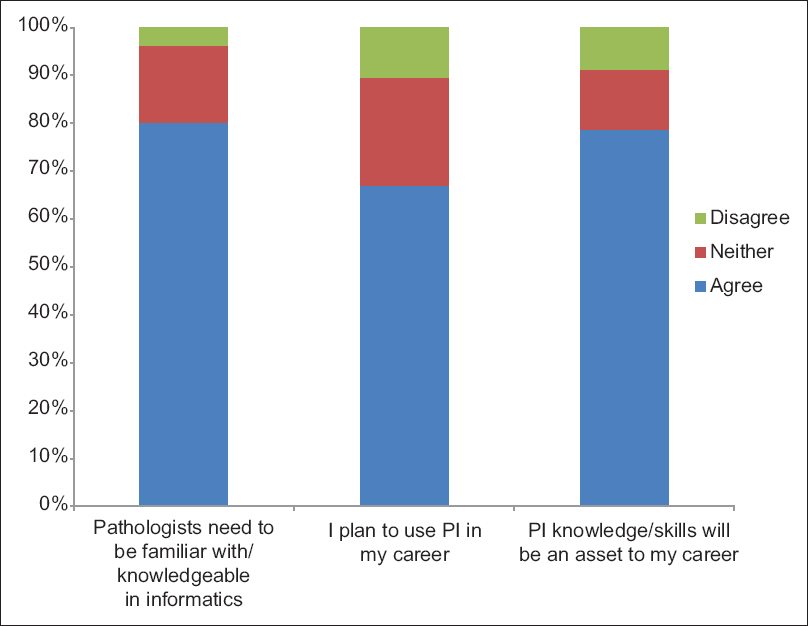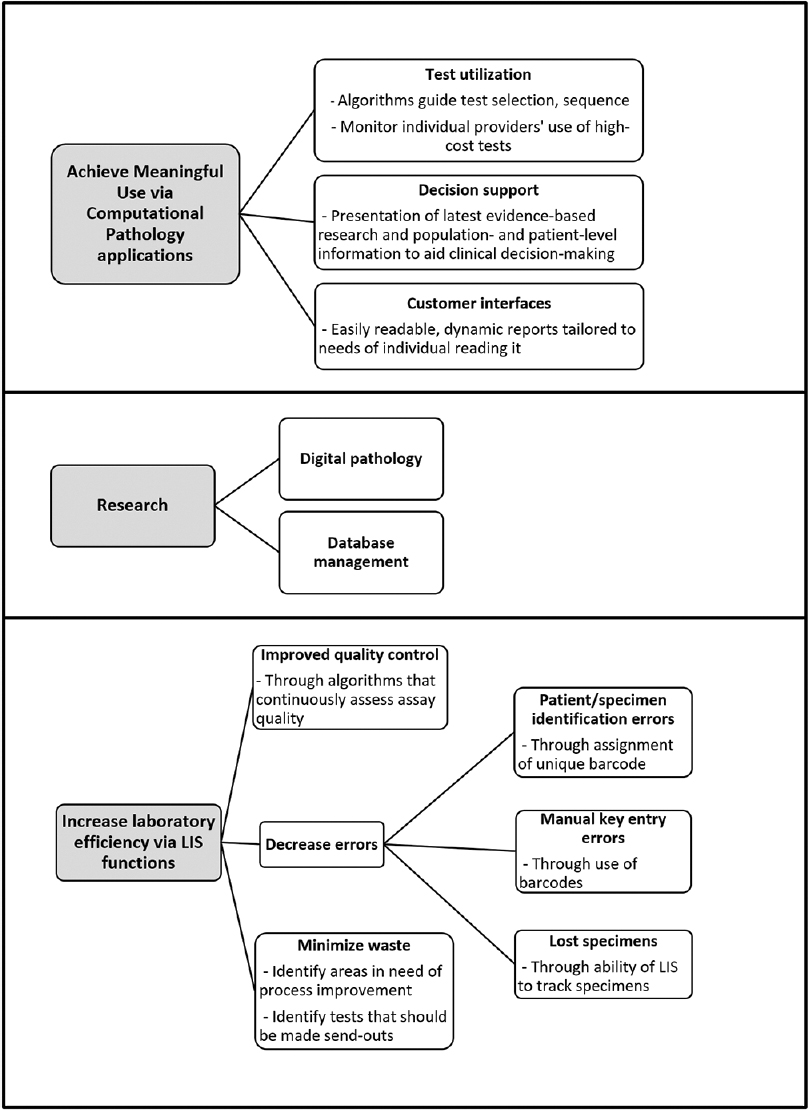Journal:Perceptions of pathology informatics by non-informaticist pathologists and trainees
| Full article title | Perceptions of pathology informatics by non-informaticist pathologists and trainees |
|---|---|
| Journal | Journal of Pathology Informatics |
| Author(s) | Walker, Addie; Garcia, Christopher; Baron, Jason M.; Gudewicz, Thomas M.; Gilbertson, John R.; Henricks, Walter H.; Lee, Roy E. |
| Author affiliation(s) | Robert J. Tomisch Institute of Pathology and Laboratory Medicine, Massachusetts General Hospital |
| Primary contact | Email: Available w/ login |
| Year published | 2016 |
| Volume and issue | 7 |
| Page(s) | 14 |
| DOI | 10.4103/2153-3539.179904 |
| ISSN | 2153-3539 |
| Distribution license | Creative Commons Attribution-NonCommercial-ShareAlike 3.0 Unported |
| Website | http://www.jpathinformatics.org |
| Download | http://www.jpathinformatics.org/temp/JPatholInform7114-4455688_122236.pdf (PDF) |
Abstract
Background: Although pathology informatics (PI) is essential to modern pathology practice, the field is often poorly understood. Pathologists who have received little to no exposure to informatics, either in training or in practice, may not recognize the roles that informatics serves in pathology. The purpose of this study was to characterize perceptions of PI by noninformatics-oriented pathologists and to do so at two large centers with differing informatics environments.
Methods: Pathology trainees and staff at Cleveland Clinic (CC) and Massachusetts General Hospital (MGH) were surveyed. At MGH, pathology department leadership has promoted a pervasive informatics presence through practice, training, and research. At CC, PI efforts focus on production systems that serve a multi-site integrated health system and a reference laboratory, and on the development of applications oriented to department operations. The survey assessed perceived definition of PI, interest in PI, and perceived utility of PI.
Results: The survey was completed by 107 noninformatics-oriented pathologists and trainees. A majority viewed informatics positively. Except among MGH trainees, confusion of PI with information technology (IT) and help desk services was prominent, even in those who indicated they understood informatics. Attendings and trainees indicated desire to learn more about PI. While most acknowledged that having some level of PI knowledge would be professionally useful and advantageous, only a minority plan to utilize it.
Conclusions: Informatics is viewed positively by the majority of noninformatics pathologists at two large centers with differing informatics orientations. Differences in departmental informatics culture can be attributed to the varying perceptions of PI by different individuals. Incorrect perceptions exist, such as conflating PI with IT and help desk services, even among those who claim to understand PI. Further efforts by the PI community could address such misperceptions, which could help enable a better understanding of what PI is and is not, and potentially lead to increased acceptance by non-informaticist pathologists.
Keywords: Education, fellow, pathology informatics, perceptions, resident
Introduction
With recent growth in the use of electronic systems to generate and manage health care data and the availability of large biomedical datasets, the practice of pathology, alongside many other medical specialties, is poised for dramatic change. The discipline of pathology informatics (PI) has emerged in the context of this relative explosion of disease-, diagnostic-, and patient-related data. With emerging technologies such as predictive analytics and management of genomic information, pathologist informaticists can anticipate expanding opportunities for PI within pathology in general and within the healthcare setting.[1]
Despite the growing importance of informatics in pathology, anecdotal experience suggests that the realm of PI remains misunderstood by pathologists. Pathologists may receive little to no exposure to PI in training[1][2][3], and what is taught may actually be more related to information technology (IT) than to informatics. Many pathologist informaticists can relate personal experiences involving requests from pathologists that are more appropriate for a technical help desk.
A divide among pathologists appears to exist between pathology informaticists (who view PI as integral to the specialty) and noninformatics-practicing pathologists (who demonstrate a possible lack of interest and understanding of PI). The purpose of this study was to examine this apparent difference in opinion within pathology. Pathologists at two large centers were surveyed, exploring themes such as perceived usefulness and relevancy of PI to personal practice, and perceived understanding of PI. Such findings could add to improved understanding of how PI stands within pathology.
For the purposes of this study, a strict, theoretical definition of PI was used as the working definition: i.e., at its very essence, the discipline is about the use, management, sharing and communication of information, which does not necessarily require technology as part of a solution. This strict definition thus includes older information management techniques present before the advent of personal computers. This working definition was used with the understanding that in recent years, the informatics discipline has become increasingly dependent on technology due to the need to automate and store today's massive amount of data. However, given the goals of the study, a clear definition of PI that excludes technology was needed.
Therefore, the working definition of the discipline focused on classical informatics theory and topics (such as knowledge representation and information retrieval). With this strict definition, IT and computer science domains such as software engineering are subject domains distinct from informatics - not part of the informatics discipline itself, but frequently used tools to enable successful informatics efforts.
This definition thus does not require physicians to acquire IT skills such as assembling computer hardware or developing software, in order to become a competent informaticist. It is also aligned with the official American Medical Informatics Association definition, which states that biomedical informatics "builds on computing, communication, and information science," treating them as distinct disciplines, as opposed to including them as part of its fundamental definition.[4]
Help desk activities were defined as activities providing services such as assembling, setting up and troubleshooting computer hardware (e.g., a nonfunctioning keyboard and mouse), and installing desktop applications. Laboratory information system (LIS) support issues, such as resetting passwords or search requests are addressed by LIS analysts, and not by typical help desk employees. However, these activities were not considered part of the working definition of informatics used in this study.
Methods
Pathology departments at two large academic medical centers that have substantially different departmental PI cultures were surveyed: Massachusetts General Hospital (MGH) in Boston, MA, and Cleveland Clinic (CC) Health System in Cleveland, OH. Differences in PI cultures between these two institutions are compared and contrasted later in the discussion.
It was decided to limit this initial study to two locations. Although the inclusion of more institutions and settings such as community practices might have added value and insight, the introduction of additional complexities to initial analysis was a possibility: For example, accounting for factors not shared by different types of settings, such as an academic center with a residency program compared to a small community group practice without residents, in drawing comparisons of survey responses. Initial findings from this limited study could contribute to and guide better study design for a subsequent effort involving more locations and settings.
To assess perceptions of noninformatics-practicing pathologists and pathology trainees (residents and fellows), a 17-question survey using SurveyMonkey (http://www.surveymonkey.com) was developed. Questions were designed to address three areas of focus: (1) Perceived definition of PI, (2) interest in PI, and (3) perceived utility of PI [Table 1]. The Likert format [inset, Table 1] was used for all questions except one. This particular question was designed to assess respondents' understanding of the differences between informatics and IT. It presented the respondent with a list of 15 activities and asked respondents to select those believed to be informatics activities. Four of the activities listed were computer help desk/pure IT situations such as troubleshooting desktop computer issues and installing new software programs on a desktop computer, which were intended as incorrect choices for informatics activities [Table 2]. An additional question asked respondents to identify themselves as a CC attending pathologist, CC pathology trainee, MGH attending pathologist, or MGH pathology trainee. The URL to the online survey, along with short description about it, was e-mailed to all pathology faculty and trainees at MGH and CC. Recipients were asked to self-exclude on the following basis: (1) Undergoing or have completed a PI fellowship, (2) actively publishing papers on informatics-related topics such as decision support or test utilization. Raw survey data was exported from SurveyMonkey to a Microsoft Excel spreadsheet for analysis.
|
|
Results
One hundred and seven respondents completed the survey: 41 of 84 eligible CC attending pathologists, 28 of 51 CC pathology trainees, 26 of 98 MGH attending pathologists, and 12 of 47 MGH pathology trainees. The list of Likert questions with response breakdown, summary, and comments is presented as Supplementary Material [Additional file 1].
Perceived definition of pathology informatics
Just over half (54%) of all respondents felt that they understood what PI is. CC trainees had the lowest self-reported understanding, at 40%, in contrast to at least 50% of respondents in all other groups [Figure 1]. The non-Likert question described earlier in the methods section, intended to assess self-reported understanding of PI, resulted in interesting findings. Out of a total of fifteen listed activities, the eleven correct PI activities were chosen by a varying majority, ranging from 92% of respondents agreeing that "reduction in inappropriate test ordering" is a part of PI, down to 56% agreeing that PI has a role in "Health Insurance Portability and Accountability Act compliance." Four activities belonging to the computer help desk domain were included on the list. Many respondents selected these incorrect choices as well, of which "resolving technology problems with display of presentations" was the most popular choice, with 45% of respondents selecting. Interestingly, help desk-type situations were selected by a significant percentage of respondents who believed that they understood what PI is [Figure 1]. In a separate question, where the term "computer help desk" was explicitly used, 20% of all respondents, including 60% of surveyed CC attendings, agreed that providing those help desk services was a part of informatics. Another preconceived notion about informatics, that computer programming or code writing skills are necessary for its practice, was addressed in another question. Fifteen percent of all respondents felt that these skills were necessary for a practicing informaticist.
|
Interest in pathology informatics
Differences between the two institutions became more evident in the answers to questions within this area of focus. While just under 70% of MGH respondents found informatics "exciting," fewer than 40% of CC respondents did. Interestingly, only 30% of all respondents who believed that computer help desk services are a part of informatics found informatics exciting.
However, 52% of CC attendings and 76% of CC trainees did express a desire to learn more about PI, as did 66% of their MGH counterparts [Figure 2]. Among respondents who found informatics exciting, 83% wanted to learn more about PI. The most pronounced difference in response rate between the institutions was observed in two questions designed to assess the impact of institutional culture on PI perceptions. About 92% of MGH attendings and 75% of MGH trainees believe that their department places a high value on PI activities, in contrast to 61% of CC attendings and 36% of CC trainees. Respondent opinions regarding the value placed on PI education by their institution's residency program were in the same vein, with 24% and 14% of CC attendings and trainees, respectively, feeling that PI education was valued highly. MGH respondents felt differently about PI education in their residency program, with 72% of attendings and 50% of trainees agreeing that PI education was highly valued [Figure 3]. About 57% and 66% of respondents who believed that their department and residency program valued PI also found PI to be exciting, while only 40% and 14% of those who did not feel that their department and residency program valued PI did so.
|
|
Perceived utility of pathology informatics
In this section, a relatively nuanced series of questions was developed to assess whether respondents found PI to be useful for both pathologists in general and on a personal level. Responses to three of the most representative questions within this area of focus are represented in [Figure 4]. Eighty percent of all respondents agreed that pathologists need to be familiar with and knowledgeable in informatics; only 4% disagreed. When asked to consider their personal careers, 76% of all respondents agreed that having informatics knowledge and skills would be an asset, and 56% felt that a lack of these skills would be detrimental. While 73% of respondents expressed an interest in including PI within their practice, with 72% acknowledging the importance of informatics to their careers as pathologists, only 65% actually planned to use PI. However, among those who found informatics exciting, 83% planned to incorporate PI into their careers.
|
As an effort to evaluate perceptions about whether or not informatics activities are exclusive to informatics-trained pathologists as opposed to being tools for all pathologists to use, the following two questions were included: (1) "I regard PI as a set of techniques for all pathologists to use, analogous to immunohistochemistry" and (2) "I regard PI as a subspecialty to be practiced only by those with PI subspecialty training, analogous to medical kidney pathology." The former question was designed to assess perceptions that informatics activities are exclusive or limited to only informatics-trained pathologists, i.e., whether pathologists would be as comfortable with taking on an informatics-related project to improve workflow processes as they would be with ordering an immunohistochemical stain in the workup of a surgical case. However, we acknowledge that the somewhat ambiguous language of this question does not necessarily direct the respondent to our interpretation, which we feel is highlighted by the near-equal, three-way split of the responses (35% agree, 37% disagree, 28% neither agree nor disagree). However, the more explicit, latter question provided more informative results. Twenty percent of all respondents believe that PI should be practiced only by those with subspecialty (i.e., fellowship) training, while 61% feel that such training should not be a requisite for the practice of PI.
Discussion
Pathology informaticists are aware of the potential that informatics applications have to enhance pathologists' ability to provide clinically actionable information by capitalizing on their unique expertise in laboratory and tissue diagnostics. The resulting improvements in patient care could further demonstrate the value of the pathologist's role. Potential opportunities for PI to enhance the value of pathology include the computational pathology initiative proposed by Louis et al., as shown in [Figure 5].[1] Realizing these opportunities will require contributions from pathologists representing a range of subspecialties and practice types, and close collaboration between pathology informaticists and other pathologists. Such collaborations might require a foundational understanding of PI by many pathologists. Accurate insight into noninformatics pathologists' perceptions of PI could help guide and improve the development of educational efforts for them. By improving their understanding of what PI can and cannot do, greater acceptance and adoption of PI by noninformatics pathologists could happen.
|
The goal of the study was to gain better understanding and insight into how PI is viewed by noninformatics-trained pathologists. As an initial project, this study focused on two large academic institutions and revealed several interesting findings. (1) Informatics is viewed positively by the majority of survey respondents. (2) Definitions of PI seem to vary greatly, even among those who believed they understood what PI is. Confusion between IT and PI, (i.e., perceived as synonymous disciplines) was evident. (3) A desire was observed at both attending and trainee levels to learn more about PI, suggesting that respondents are cognizant of their knowledge deficit in the subspecialty and are interested in remedying it. (4) While the majority of respondents believed that having some knowledge in PI would be professionally useful and advantageous, a somewhat smaller number planned to use it, which is perhaps reflective of the lack of a solid comprehension of what PI is, can do, and cannot do.
Overall, the survey showed that respondents were enthusiastic about informatics without necessarily understanding what it is. This combination can be problematic, as misperceptions of PI among pathologists unfamiliar with PI, especially if coupled with pathology informaticists' unawareness of the specific misperceptions, could lead to unrealistic expectations and frustrations on both sides. Left unchecked, misperceptions have the potential to further any marginalization of the PI subspecialty, distancing pathologists from the pathology informaticists who possess the unique skill sets needed for optimal application of informatics to enrich the value of laboratory operations. These consequences suggest a need for the PI community to actively work towards correcting misperceptions in the greater pathology community.
Thus, our study raises the question: How can pathology informaticists change these incorrect and undesired perceptions of a subspecialty that is so different from the traditional concept of the specialty it will benefit most directly? Education is one obvious approach, but historically, lasting success has been difficult to achieve or sustain. Difficulties with PI education due to inadequate resources have been well described in past literature.[2][3][5] Well-intentioned efforts have ultimately not succeeded over time: The dedicated PI rotation at the University of Pittsburgh Medical Center, using pre- and post-tests[6] is no longer in use (and it is unknown how much informatics knowledge from the rotation is retained by the resident later), a web portal that is no longer active[7], and a wiki site[8] that generated much interest initially but ultimately did not capture the sizable user base necessary to keep the content in the wiki active.
References
- ↑ 1.0 1.1 1.2 1.3 Louis, D.N.; Gerber, G.K.; Baron, J.M. et al. (2014). "Computational pathology: An emerging definition". Archives of Pathology and Laboratory Medicine 138 (9): 1133–8. doi:10.5858/arpa.2014-0034-ED.
- ↑ 2.0 2.1 Goldberg-Kahn, B.; Healy, J.C. (1997). "Medical informatics training in pathology residency programs". American Journal of Clinical Pathology 107 (1): 122–7. doi:10.1093/ajcp/107.1.122. PMID 8980379.
- ↑ 3.0 3.1 Henricks, W.H.; Healy, J.C. (2002). "Informatics training in pathology residency programs". American Journal of Clinical Pathology 118 (2): 172–8. doi:10.1309/4CE8-N2MX-DFG6-N8H9. PMID 12162674.
- ↑ "The Science of Informatics". American Medical Informatics Association. https://www.amia.org/about-amia/science-informatics. Retrieved 01 January 2016.
- ↑ Sinard, J.H.; Powell, S.Z.; Karcher, D.S.. "Pathology training in informatics: Evolving to meet a growing need". Archives of Pathology & Laboratory Medicine 138 (4): 505–11. doi:10.5858/arpa.2013-0328-RA. PMID 24678681.
- ↑ Harrison Jr., J.H.; Stewart 3rd, J.. "Training in pathology informatics: implementation at the University of Pittsburgh". Archives of Pathology & Laboratory Medicine 127 (8): 1019–25. PMID 12873178.
- ↑ Kang, H.P.; Hagenkord, J.M.; Monzon, F.A.; Parwani, A.V. (2009). "Residency training in pathology informatics: A virtual rotation solution". American Journal of Clinical Pathology 132 (3): 404–8. doi:10.1309/AJCP6YXB6ODKTDQI. PMID 19687317.
- ↑ Kim, J.Y.; Gudewicz, T.M.; Dighe, A.S.; Gilbertson, J.R.. "The pathology informatics curriculum wiki: Harnessing the power of user-generated content". Journal of Pathology Informatics 1: 10. doi:10.4103/2153-3539.65428. PMC PMC2929539. PMID 20805963. https://www.ncbi.nlm.nih.gov/pmc/articles/PMC2929539.
Notes
This presentation is faithful to the original, with only a few minor changes to presentation. In some cases important information was missing from the references, and that information was added.
